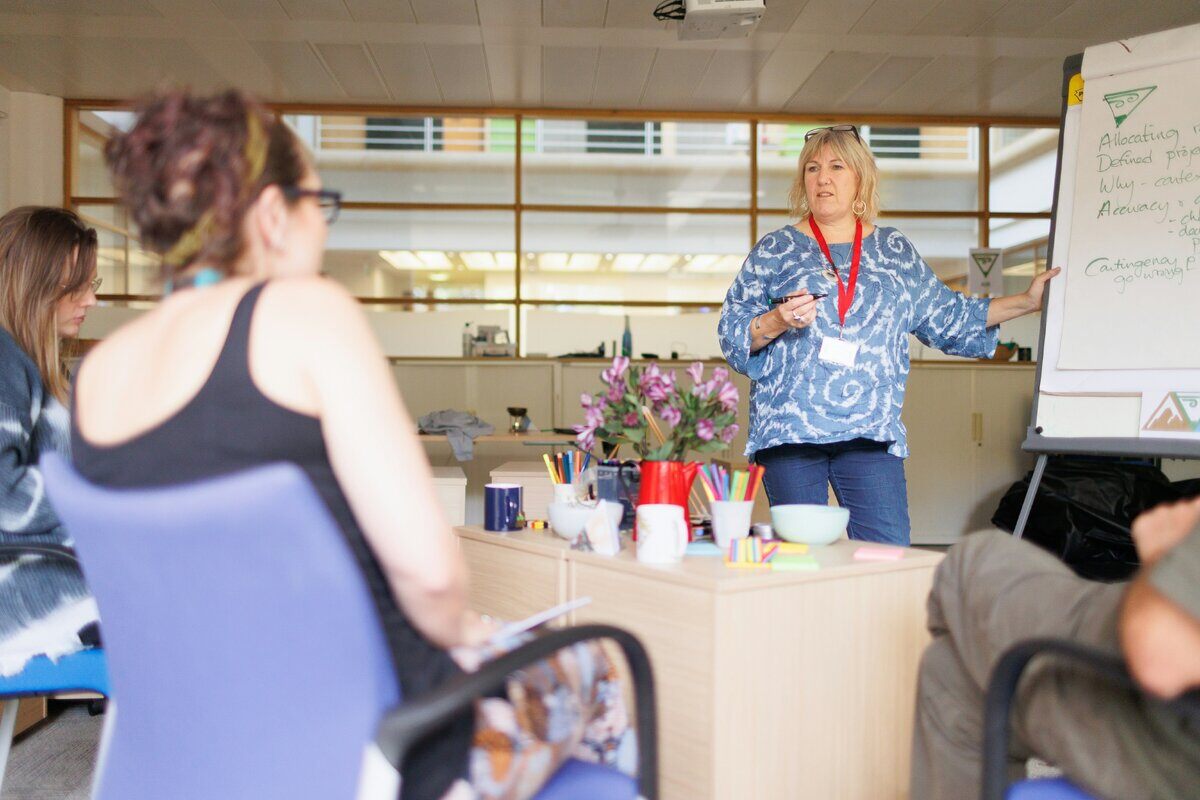
Workforce Skills List: Building a Skill-Based Workforce Through Blended Learning

The pandemic's effect on the economy and workforce culture has shown us that we need to take a closer look at the ways in which we approach productivity.
Throughout history, we have built organizations around hierarchies of position.
These hierarchies have been based on demonstrated merit over time.
This paradigm is older than trees.
But, it may be an organizational format whose time has come and gone.
Today, we are looking to a new organizational model known as the Skills-Based Organization (SBO).
In this article, we will discuss the definition and merits of SBOs and discover how we may build and develop them.
Finally, we will explore how we obtain the workforce skills we need via blended learning.
What Is A Skills-Based Organization?
A skills-based organization is put together according to the requisite skills rather than according to hierarchies or job titles.
In such an organization, people are put into the positions they hold in accordance with the skills they possess, rather than according to seniority, ownership, or other more traditional considerations.
The head of talent and workforce transformation at Mercer, Marcus Downing, compares an SBO to a Lego set where each piece is represented by a skill held by an individual.
Looking at it this way, it's fairly easy to imagine what we are working with when we have an SBO at our disposal.
Taking the analogy further, we can consider the fact that there are different types of Lego kits.
There are ones that make spaceships, others that make little houses, and so on.
With each kit type, we would have specific sets of Lego blocks.
Those blocks represent specific skills in an SBO.
If we wanted to build an SBO designed to produce and sell athletic shoes, for example, we would need specific types of skills with which to do this.
We would need people to run the machines that make the various parts of the shoes.
We would need assemblers for the parts.
We would also need sales professionals, designers, and so on.
What's important here is that we place emphasis on the skills themselves rather than work history, background, or authority.
We build our organization out of the skills we need to deliver our product or service.
At its most fundamental level, an SBO is more of a way of viewing and operating an organization than it is a type of organization.
It is a way of producing value using skills as our primary form of capital.
So, now that we understand what a skills-based organization is, let's answer the next logical question: "Why would we do business this way?"
Benefits Of Skills-Based Organizations
According to the Deloitte Foundation, skills-based organizations are:
- 107% more likely to place talent effectively
- 98% more likely to have a reputation as a great place to develop professionally
- 98% more likely to hold on to top performers
- 79% more likely to have workers report a positive workplace experience
- 57% more likely to anticipate change and respond effectively
- 52% more likely to innovate
- 49% more likely to intentionally maximize efficiency
Grow Your Talent Pool
In traditional hiring, we tend to look for candidates who have jumped through certain hoops, completed specific degree programs, or have been in the field for a given period of time.
When we place skills at the forefront of our hiring and talent placement tasks, we begin to see the folly in this.
You can have someone who has done all of the above but lacks the skills to be effective.
Then, when failure arises, we blame the employee, and they blame the organization at the same time.
In a skills-based organization, we break a role to be filled down into the tasks that make up that role.
Then we seek out candidates who possess the skills by which we have defined the role.
If we are hiring for a specific role, we start by looking for candidates who possess the skills that define the role.
From there, we have two choices.
We can look for people who already possess the requisite skills, or we can seek to endow an in-house candidate with those skills.
If we take the second route, we do so through skills-based learning.
In this way, we find that our talent pool is much larger than it appears when we look at it through a traditional human resources lens.
Become Future-Proof
In a skills-based setting, we solve a problem by fitting the right person to a given task.
In traditional human resources management, we look at people as known quantities.
We accept or reject them in accordance with their demonstrated adherence to organizational norms.
In a skills-based workplace, we look to fit skills to a task rather than people.
This means we may have a senior employee who has all but one of the necessary skills to fill a new role. In a traditional workplace, we would look for a new candidate.
This costs time and money, and we lose the value baked into our senior employees.
In a skills-based workplace, we would most likely seek to teach our veterans the new skill needed for the role.
Clearly, the second route is faster and more efficient than the first.
This means your company becomes more agile because you are able to fill out new roles as the need for those roles arises.
Of course, our example is just one way to fit skills to the role.
We have many potential options when we think in terms of skills rather than in terms of types of professionals.
Shoot For The STARS
When we limit our talent searches to traditional hiring paradigms, we lose out on talent who have obtained their Skills Through Alternative Routes, or STARS.
Alternative routes to skills may be gig work, community colleges, bootcamps, workforce training programs, or even hobbies.
Businesses have been overlooking STARS for centuries.
But we don't have to make that mistake anymore.
Workforce Skills List
Back to Marcus Downing's Lego kit analogy: think of your organization as a set of skills rather than as a hierarchical tree.
What kinds of bricks are in your box?
Here are a few skill categories you can consider as skill types you might draw from to build out your organization from the bottom up.
Computer skills
- Word processing
- Spreadsheets
- Coding
- Social media
Tech skills
- Product knowledge
- Trade-based expertise
- Tool-based expertise
Collaborative skills
- Communication
- Teamwork
- Leadership
Organizational skills
- Workspace organization
- Time management
Sales skills
- Demographic research
- SEO marketing
- Branding
While these are somewhat broad, the key to finding the skills you need to locate and develop is simple.
It's just a matter of determining what needs to be done to deliver the value proposition your business model is built on.
From there, you want to find people who have those skills, train your existing team to possess those skills, or implement a combination of training and hiring.
How To Implement Skills-Based Learning In Your Organization
To equip our teams with the skills they need, we have two approaches at our disposal: reskilling and upskilling.
They are the fundamentals of skills-based training.
Reskilling
This is when we start from scratch, training someone who does not yet possess the skills needed to fill a certain role.
Sometimes this is the optimal route, such as in entry-level positions.
As technology changes, senior people can also benefit from reskilling.
In this way we ensure we rise to new challenges as they emerge.
Upskilling
Sometimes upskilling is just a refresher course in a skill the learner already possesses.
Of course, as the economy and technology change, upskilling often means reworking existing skills to bring them up to date.
These two modes of skills-based learning are not mutually exclusive.
You can do both, and in most cases, we think you'll find that you need both.
In fact, it really depends on the knowledge base of the individual.
After all, what is a reskill for one team member is an upskill for another.
Filling In The Skill Gaps
In a recent McKinsey survey, 87% of companies across the globe reported that their workforces suffered from skill gaps.
In a traditional setting, we usually wait until skill gaps result in some kind of material loss.
That's when people get blamed, fired, and worse.
The skill-based framework is all about installing the skills that an organization needs to function before a critical failure occurs.
To do this we must first accept the fact that there will be gaps in the knowledge/skills we have on hand.
Then, we must seek out those gaps, and identify what and where they are so that we can fill them using skill-based learning.
Ways To Incorporate Skills-Based Learning In Your Blended Learning Program
Now, this is where the rubber hits the road.
Blended learning has been with us since at least the 1960s.
But, it has taken the full integration of information technology with economic drivers for blended learning to be fully and widely implemented.
That being the case, we have at least 20 years of solid data supporting the effectiveness of the model, and it's still evolving.
Blended learning works because it makes learning flexible.
It gives you the ability to cater to the optimal learning styles of your teams.
It also makes it easy to allow them to work at their own pace.
Arguably, these are the two strongest virtues of the blended learning model.
Therefore, we strongly recommend prioritizing preferred learning methods (ie, visual, verbal, tactile learning) and allowing your teams to work at their own pace insofar as you are able.
5 Blended Learning Models
You can learn more about blended learning models here, but for now, let’s take a quick look:
- Flipped classroom: The flipped classroom model is centered around independent study where the student consumes lectures, reading material, and tasks remotely, consulting with material and with instructors as needed.
- Digital assessments: Digital assessments are a great streamlining tool for skills-based learning. Digital assessment enables you to automate assessment processes, taking a huge amount of paperwork off the desk of the instructor. Typically, students will have multiple opportunities to complete the assessments, making the assessment itself an important part of the training process.
- Digital revision tasks: Taking the data of aggregate student performances into consideration, we use the remediation needs of the entire student population as a way to guide the focus of the study. By monitoring the results of digital assessments, we can develop laser-focused training modules to streamline the training process.
- Multimedia tools: Ideally, we want to present the information in as many ways as we can so as to cater to all the preferred learning styles of our students. Multimedia presentations give you the ability to record a lecture, offer transcripts, and provide visual and interactive learning tasks. This way, fewer learners will fall behind because their optimal learning mode is not offered.
- Virtual office hours: Interestingly, conversation is a preferred learning mode in its own right. Some learners will have trouble assembling a knowledge set or skill until certain key bits of information are filled in. For these students, and for any who have questions, we recommend offering virtual office hours.
Conclusion
We think you'll find that the combination of digital assessments and aggregate revision tasks, in particular, have the ability to zero in on specific skill sets that need to be filled in.
When we fully adopt the skills-based organizational philosophy, we begin to curate a workplace where missing skills are seen as a need to be filled, rather than as a fault of the worker.
In this way, workforces become more robust and morale soars.
At the same time, loyalty to the company grows, and your teams become real partners you can rely on to be productive and energetic.
If you need help in building your own skills-based organization, contact us!
Sources
- https://www.youtube.com/watch?v=BhhmLHUGEiU
- https://www.linkedin.com/pulse/skill-based-organization-ambassador-paul-gitau
- https://www2.deloitte.com/us/en/pages/human-capital/articles/the-skills-based-organization.html
- https://www.randstadusa.com/business/business-insights/talent-acquisition/7-benefits-skills-based-hiring/
- https://www.mckinsey.com/featured-insights/coronavirus-leading-through-the-crisis/charting-the-path-to-the-next-normal/mind-the-skills-gap
- https://www.thevirtualtrainingteam.com/what-we-think/the-history-of-blended-learning/






